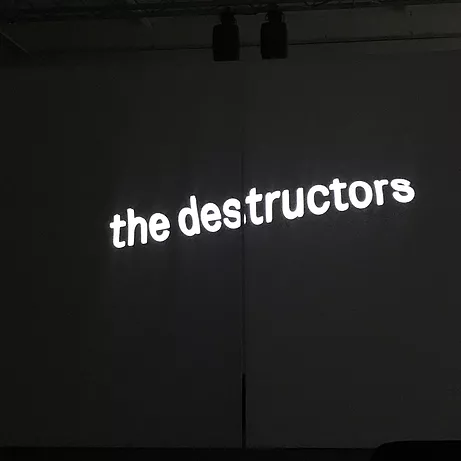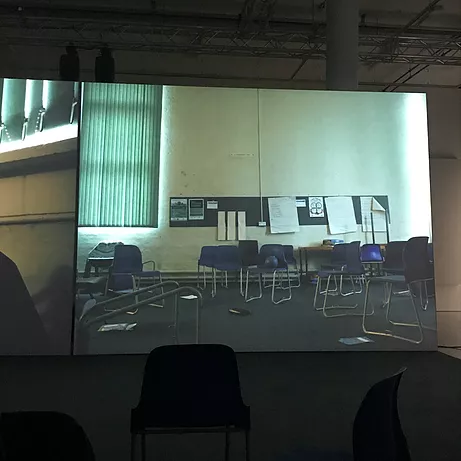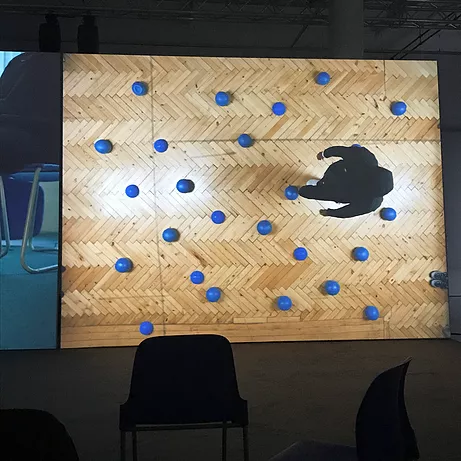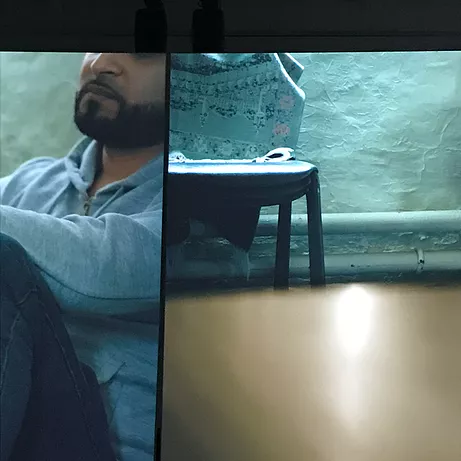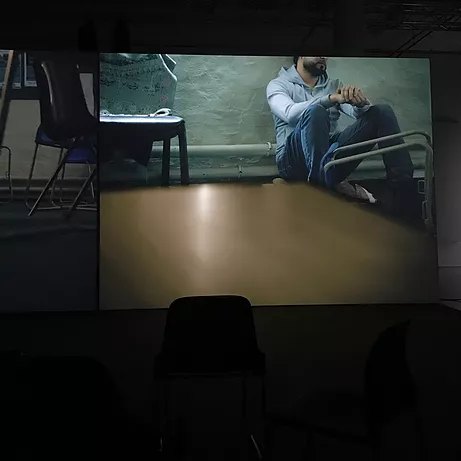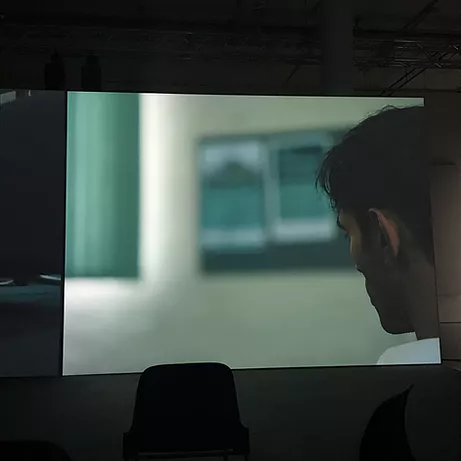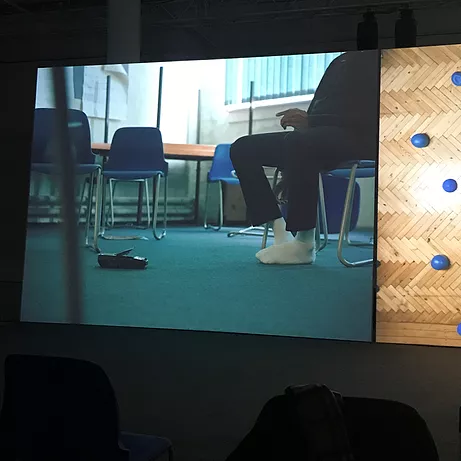Imran Perretta: the destructors @ Spike Island
ZM
Emoji summary: (i literally don't know)
I’m glad I’m writing this hot off my brain, a week after Gab’s review of Mark Leckey’s Tate Britain show; because she mentioned how nice it was to circle back to the same artist over again, how she calls herself a Mark Leckey fan bc of this continual visiting. This is a smooth gradient in to something parallel for me, the same closeness in audience-ship. I have written about Imran Perretta’s work a few times and often I feel like I’ve been overfamiliar. It’s been hard to write about his work and not just end up talking about myself & the images specific to my mind’s eye that his work references. I think maybe looking back, the works of his that I’ve seen have held an aesthetic of silence; withdrawn, they’ve had the personality of someone who is careful with their words, so you fill the spaces in between and natter on. I mean, I wouldn’t say this work is too different, but maybe there’s a different deployment of this ~aesthetic of silence~? I mention this all to say: this work felt like a rupture in this pattern of visitation, there’s a small shift in weight. I don’t want to write this review using myself; I want to write it through myself, self as conduit and filter, rather than destination.
Imran Perretta’s, the destructors, is showing at Spike Island in Bristol. I nipped in on a Friday off, press-trip life, sneaky preview. It’s a 2-screen, 3-act narrative, 3- Bengali actors monologuing, but the narrative takes you into a knotted circle - -. The screens face a cluster of unevenly spaced blue plastic chairs that appear in the film; and you never see the actors’ full faces. The framing avoids your gaze, purposeful, deliberate.
The monologues are set against the backdrop of a series of very public looking buildings, back-rooms of community centres, youth clubs, gymnasiums, school hallways. There is a ripeness in the loaded aesthetic of public buildings: in their closure, in their absence, decay, in the deployment of classrooms for the means of state-surveillance (Prevent) - it’s an uncomfortable undercurrent that rumbles away. This backdrop is a void and absence, nostalgia filling the space between.
The film opens with sound; percussive slapping, at first like stumbling / and then fuller it comes like waves / then knees and hands / crisp white thobe under a bomber jacket / Fila sneaks / fresh trim akh. Crescendo rises, peaks, cuts out.
Act 1; public absolution (the implicit undercurrent of guilt): this act details a public confrontation between the narrator and a stranger, in a public space. The stranger says, ‘i forgive you’ ‘i want you to know that YOU are forgiven’ ‘i forgive you for the bombs’. Loaded primed it is the silence swollen within confrontation between the public and monolith, made palpable. This is an interaction I have heard from a thousand people a thousand times since 2001, I don’t remember life without it. This has simmered into my normal and I feel a tightness in my chest, as the narrator describes a lump in his own throat. The silence on our end feels solid, real, poisonous, the shame of feeling fear in the face of someone else’s bravery, to speak what you implicitly knew - into words. And somehow this utterance takes it from loose abstract to real sweat; it conjures (?is that what performative utterance is). Because it’s either public absolution as a given, or public absolution pending an apology; either way, both scenarios start at the same point: <We> are assumed to be guilty, so <We> are not a part of the <Public>. We are separate. I don’t remember the towers falling, but I remember what happened after. I remember the separation of Self from Public. And then in absolution: the separation of <Self> from <We>, the assumed monolith. We are forgiven for the guilt assumed of <Us>, but it is a hollow guilt (that we never had any agency or handling of). The narrator calls it ‘another’s supreme fiction’ and I don’t know what that refers to: the fundamentalism we are trying to deny as our own, or the narrative that we are holding this fundamentalism in our own two hands. It is tight, inscrutable, how do you know where to start to unpick that? In its compact neatness it can only be met with silence. The first act establishes the ground-floor: the means, the manner and the subject of alienation.
The school hallway fills with water. First a wash, then a sheet, then puddle. It ripples as it fills across, pooling.
Act 2; we lean in to the push. If we are now separate, (aside from the Public) (not Us, but Them) then what now? How can you be in public space when you are the subject of surveillance and the Public has placed themselves in opposition to your presence? The narrator glosses over a series of terms that describe Someone, but it’s never a description that sticks (other than as a part of that Supreme Fiction of AnOther - that is separate internally, again): Police identity codes, ‘axis of evil // deviants // destructors’. These descriptions are assumed; they could be false, but yet again, there’s something in someone else uttering it that makes them true - partially as categorisation but also as perception. Bc ‘at the hard end of the deep state’, perception is tied up and presented as equally weighted to truth. In this mix between perception (External & assumed) and truth (Internal & known), ‘it’s not about who you claim but about who claims you’ an identity forged out of what it opposes (or here, what it is unwillingly placed in opposition to). In this separation of <We> from Public, there is an internal logic & understanding - a tender acknowledgement of a mutual pain, ‘armoured against each pale stare’ trauma bonding. An identity forged out of what it opposes, ye, but it is also lowkey scripture: <We> are one ummah. But where the ummah is an identity bound with solidarity & kinship, a synonym for community (whatever that means); this alienation balloons, is traumatic because it is based in a reduction, a purposeful misunderstanding. ‘weighing heavy on our whole // and we are here because there’s nowhere else we can be’. What does dehumanisation feel like from the inside? Water pours from a stairwell, down, slapping. This is where the tightness in my chest begins to rise, to my throat and the soft tissue under my chin. ‘in each other we are measuring the extent of our selves // young innocents full of infinity’, this heaviness intersects with what’s implied is the narrator’s identity; adolescent, emergent, still soft to the touch. ‘at the hard end of the deep state // we’re just trying to survive the condition we find ourselves in // under protected and over exposed’. Like when a cut breaks the skin, and it takes a second for the blood to rush to the surface - this act describes a delay. The absolution of the 1st act is only momentary, individual, ‘you’re alright, but idk about the rest of youse’. It is deeper than these interpersonal moments, and act 2 amplifies the affect of these moments on a scale bigger than just one individual tiny person. It doesn’t have the weight to contradict the identity of the collective. Bc although we are one ummah, we are also migrant hoarde, scourge and swarm, Unknowable Other - the scale this faces (the carceral state, the other countless institutions that we must pass through) matches. But the narrator’s words also burrow in from the inside, shatters the scale underhand - presents what it’s like to catch the wave of it. ‘we are measuring the extent of our selves’, where does the self & the body begin, end, curl up & meet in the middle - if you’re within this systematic dehumanisation as a person, in the midst of transformation from the inside & out. Measuring, the extent, of Our Selves.
This time, as it cuts to the hallway, there is an echoed rhythmic slapping. The water rises higher. Focus pulls. Sound cuts.
Act 3; has made me cry 4 times total. It takes the last 2 acts and a new violence entirely, swallows them all (with the shell). Softens in the face of it, still. Between these points: state-sanctioned islamophobia, the over-policing of black & brown men, interpersonal violence that has institutional repercussions, dehumanisation of Othered post-colonial subjects, austerity and the gradual but purposeful dismantling of public services and spaces, social death, caring for someone you love dearly dearly dearly. Where the state fails, ends, falters and doesn’t extend to you, by fact of your separation. ‘there’s this ulcerous rage // that I fear will immolate undyingly // and if I let it touch all my sides I know // it will lay waste to the softest parts of me’. There is also potential for a tenderness to emerge, for a human body to be centred within. ‘she would hold me still // talk me down from all these unthinkable masculinities // wait for me to relent // to soften .. so that I would know without a doubt that my body belonged safely to someone // even if it did not feel like it belonged to me’. And it is tender tender careful to sensitively recenter the human, the individual, the subjective body within this writing, that so precisely describes an intimate and pervasive kind of dehumanising violence. To clip the end with that, to present a tender denial. Not justification, explanation, capitulative posture, just a refusal to fold in to the equal truth: ‘that embodiment would be an everyday cruelty’.
I have purged bile, traced a finger along the protruding ridges of my ribs; I have not known how to release the residual energy a parallel violence leaves as an after-burn. My eyes burn in the dark of the gallery, as I try not to cry in front a group of people I don’t rly know well enough to cry like that in front of. The film ends in a soft silence; the 3rd actor finishes his narration, the screen across pictures him falling backwards, arms crossed, out of shot. Soft reverb, the sound grumbles out.
This film is beyond art, and that is why it hit me with such velocity. It is sensitive; a careful and cultivated tender sincerity. I cannot tell you how much I truly rate Imran for taking these stodgy Capitalised entities, that could slip into unexplainable normalcy, he burrows into them and shrinks them to the size of a body. I left the dark of the screening room, n asked him; ‘do you think people will understand this?’ Watching this film had been such an internal, insular and wrenching process, guttural and specific. It is traumatic, I was watching a description of narrated trauma too. For a while, I couldn’t break the cynicism that this film would be met with anything but silence. I thought it was bleak, sad, past truth and into a kind of nihilism that describes a point of inertia. I was unsure what would (or could happen) in the In or Outside of a gallery. Where the film presents this sensitive description of trauma with trembling hands, what does it do? What can art Do? As an object, I don’t have faith that art can change anything, what happens now there’s a gaping wound, pus, blood, plasma, goop, what’s at the other end of that?
I can’t really remember Imran’s answer, but I think now the film has sat with me for a week, I’ve shifted. It’s not really about the silence; it’s about the action that unfolds within the narration, the circle of the 3 acts, and the multitude of violences and tendernesses that they describe (in word & action). It moves through from beginning to end, dodging and weighing the interplay between academic & Political entity // and the <We> as individual, softly refusing to let the former go without being checked by the latter. In that checking, it is an anchor, a system of articulation that prioritises a felt reality; it holds down points of separation and makes these moments accountable to their own identification. It might not be understood, even by me, but I’ve broken my cynicism about how much that actually matters. I’m not convinced this work belongs in a gallery. It is so deep from within a completely separate place; a gallery as a site is not primed or deep-cleaned enough to house it. A gallery is an imperfect lumpy ground for it to sit in, it has jagged edges that could snag and where this film could open up a sore, a gallery doesn’t invite in the people who could act as salve. Still, in the face of that; the destructors collapses a distance between the Felt and the larger moving of the World, the State, the Academic, vague and edgeless grand players that have assimilated into my every day as a smoky immutable. Biopower, social death, cognitive dissonance; cool, ye, but what do the walls of that specific point feel like from the inside? In collapsing this distance, there’s a reconciliation between an academic, political, rigorous but vacated and unsympathetic understanding - and affect.
I cried another 5th time while writing. Tender tender, it is in this shrinkage that I am reminded of a humanity I have forgotten to claim, forgotten to assert at specific times. In the transformation and reclamation of these foreign separations as entirely constructed and mutable; it has satisfied a craving for the alchemy of overhaul - when my body has not been my own, this film made me remember to call for it & believe that it would answer back.
Imran Perretta's the destructors is at Spike Island (Bristol) until 8th December. There's a few public program bits on, here.Then it'll be on tour; at Chisenhale (London) from mid-Jan, BALTIC (Gateshead) from March, & the Whitworth (Manchester) from May.
